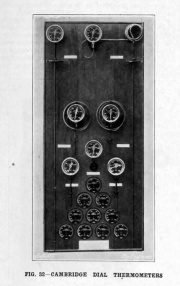Cambridge Instrument Co



Cambridge Instrument Co, maker of scientific and medical instruments
of 13 Grosvenor Place, London, SW1. Telephone: Sloane 9164 (5 lines). Cables: "Unipivot, Sowest, London". (1947)
1881 Cambridge Scientific Instrument Co established by Horace Darwin and Albert George Dew-Smith to manufacture scientific instruments. Darwin was first apprenticed to an engineering firm in Kent, and returned to Cambridge in 1875. Dew-Smith was an engineer and instrument maker who was at Trinity College, Cambridge with Darwin.
1895 Public company.
1895 The partnership became a Limited Liability Company.
1896 Edgar Isaac Everett left to form Everett and Co
1898 Robert Stewart Whipple was appointed personal assistant to Horace Darwin, and later became Managing Director and Chairman of the company. He amassed a unique collection of antique scientific instruments that he later donated to found the Whipple Museum of the History of Science in 1944.
1898 William Pye, who had joined as foreman, left in 1898 to form the W. G. Pye Instrument Co with his son, which ultimately became the Pye group of companies.
1919 Name changed.
1920 It took over the R. W. Paul Instrument Co, of London, and became the Cambridge and Paul Instrument Co Ltd.
1924 Became the Cambridge Instrument Co. The name was shortened when it was converted to a Public limited company.
1937 Scientific instrument makers. [1]
S. W. J. Stubbens, a foreman, left to form Unicam Instruments Ltd.
1947 Listed Exhibitor - British Industries Fair. Manufacturers of Scientific and Industrial Precision Instruments for almost every purpose including Measurement and Control of Temperature, Pressure, Humidity, Electrical Measurements, Chemical and Gas Analysis, Engineering Instruments, Medical and Special Research Instruments. (Olympia, Ground Floor, Stand No. A.1078) [2]
1958 Introduced the electron probe microanalyser, for non-destructive determination of the elements within a very small area of a specimen. Although originally designed for metallurgical and mineralogical specimens it was later to be used by chemists and biologists.
1959 Shares floated on Stock Exchange[3]
1961 Manufacturers of scientific instruments, including temperature measuring instruments, precision electrical measuring instruments, also indicators, recorders, controllers and medical instruments. [4]
1964 The scanning electron microscope was introduced, developed from Cambridge University's Engineering Department's work. This had advantages over the established transmission electron microscope, which used very thin specimens, in that solid specimens could be examined.
1968 The company was taken over by the George Kent Group, helped by the Industrial Reorganisation Corporation, forming the largest independent British manufacturer of industrial instruments. The company was split between 4 divisions.
1968 Queen's Award to Industry for Export Achievement [5]
1971 Merged with the Foster Instrument Co to form Foster Cambridge[6] .
US and Japanese competitors were winning business from Cambridge for electron microscopes; the company was making a loss.
1973 Abortive attempt by George Kent to sell Cambridge Instrument Co to private company Metals Research[7]
1974 George Kent was acquired by Brown, Boveri and Co. The group was split into two parts Brown Boveri Kent and a new company Scientific and Medical Instruments which would take in Cambridge Instrument Co; SMI needed state aid in order to establish the business[8]
1975 Scientific and Medical Instruments was merged with a private company Metals Research and renamed Cambridge Instrument Co but losses continued because of downturn in the market for scientific instruments[9]
1976 The government's stake in Brown Boveri Kent and Cambridge Instruments, after injection of several £million to cover losses, was transferred to the NEB[10]
1976 After another loan, the National Enterprise Board controlled a majority of the company[11]
Ownership by the National Enterprise Board enabled major reorganization of the company.
The company achieved a number of firsts - a machine for producing gallium phosphide commercially for use in LEDs; a commercial brain scanner; one of the world's first scanning electron microscopes; the first commercial epitaxial reactor to deposit semiconductor material on silicon wafers[12]
1979 Cambridge Instruments was one of the first of the NEB's companies to be privatized
1980 Acquired 2 of the medical equipment divisions of Warner-Lambert; also launched electron microscopes and electron beam machines for manufacturing microprocessors; developing robots and automation equipment[13]
1980 GEC acquired Pickering Corporation as a move into medical instruments in association with Cambridge Instruments[14]
1983 Cambridge Instruments acquired Londex[15]
1987 Company floated on the Stock Exchange[16]
See Also
Sources of Information
- ↑ 1937 The Aeroplane Directory of the Aviation and Allied Industries
- ↑ 1947 British Industries Fair p53
- ↑ The Times, May 02, 1959
- ↑ 1961 Dun and Bradstreet KBE
- ↑ The Engineer of 26th April 1968 p650
- ↑ [1] British History Online
- ↑ The Times, Oct 14, 1975
- ↑ The Times, Nov 15, 1974
- ↑ The Times, Dec 09, 1976
- ↑ The Times, Jan 21, 1977
- ↑ The Times, Dec 09, 1976
- ↑ The Times (London, England), Friday, March 27, 1987
- ↑ The Times May 09, 1980
- ↑ The Times, Monday, Dec 08, 1980
- ↑ The Times, Oct 06, 1983
- ↑ The Times, March 27, 1987
- Cambridge Museum of Technology [4]








